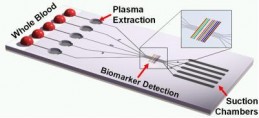New blood analysis chip could lead to disease diagnosis in minutes
March 21, 2011

SIMBAS chip showing blood loading area, plasma separation microtrenches, detection sites, and suction flow structures (Illustration: Ivan Dimov)
A new biochip is able to process whole blood samples without the use of external tubing and extra components, says Luke Lee, UC Berkeley professor of bioengineering and co-director of the Berkeley Sensor and Actuator Center.
The biochip uses trenches patterned underneath microfluidic channels that are about the width of a human hair. When whole blood is dropped onto the chip’s inlets, the relatively heavy red and white blood cells settle down into the trenches, separating from the clear blood plasma. The blood moves through the chip in a process called degas-driven flow.
Air molecules inside the porous polymeric device are removed by placing the device in a vacuum-sealed package. When the seal is broken, the device is brought to atmospheric conditions, and air molecules are reabsorbed into the device material. This generates a pressure difference, which drives the blood fluid flow in the chip.
The researchers were able to capture more than 99 percent of the blood cells in the trenches and selectively separate plasma. The biodetectors in the chip provided a readout of the biotin levels in 10 minutes.
The international team of researchers led by Lee have dubbed the device SIMBAS, which stands for Self-powered Integrated Microfluidic Blood Analysis System. SIMBAS can create an effective molecular diagnostic biochip platform for cancer, cardiac disease, sepsis and other diseases, says Lee.
Their work appears as the March 7 cover story in the journal Lab on a Chip.